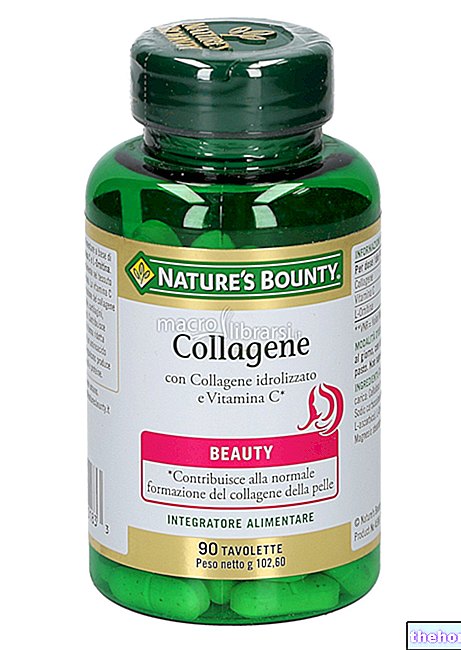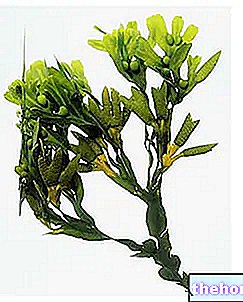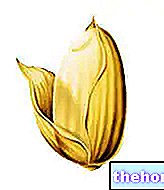Generality
Gamma oryzanol is a blend of esterified sterols, ferulic acid and triterpene alcohols.
Its name derives from the rice plant (Oryza sativa), from which it is extracted. It is obtained, in particular, from rice bran oil, but it is also present in other products, such as corn, barley, wholemeal flours, olives and various types of fruit.

Also used in cosmetics as a natural sunscreen, gamma oryzanol is used daily in oriental medicine as a tonic-invigorating, anti-anxiety, anti-inflammatory and gastroprotective agent.
Despite the many uses made in traditional medicine, currently "only" anti-inflammatory, antioxidant and lipid-lowering properties are scientifically attributed to gamma oryzanol.
Indications
Why is gamma oryzanol used? What is it for?
Gamma oryzanol has entered the world of nutritional supplementation for several years now, but it has not yet been possible to fully clarify its potential biological role.
Currently, gamma oryzanol is mainly used as:
- Antioxidant agent;
- Anti-inflammatory agent;
- Hypocholesterolemic agent;
- Gastro-protective agent.
The more noble anabolic and neuroendocrine activities of gamma oryzanol would not yet be supported by noteworthy scientific evidence.
Properties and Effectiveness
What benefit has gamma oryzanol shown during the studies?
Although most of the studies currently published on gamma oryzanol are experimental, interesting peculiarities of this molecule would begin to emerge.
Gamma oryzanol and inflammation
The anti-inflammatory activity of gamma oryzanol seems to be attributable to the ability to inhibit the expression of some genes, such as NF-KB, protagonists of the inflammatory response.

Experimental data would show the usefulness of gamma oryzanol in the course of intestinal inflammatory pathologies, induced by harmful agents.
Great efficacy would have been observed against gastric pathologies, such as gastritis and peptic ulcer.
Gamma oryzanol and oxidative stress
Gamma oryzanol was found to be effective in countering the damaging effects of oxygen free radicals.
The antioxidant activity, mediated by the direct scavenger action, would have determined, in various experimental models, an appreciable reduction of some markers of oxidative damage.
Protection from the lipoperoxidation process would make gamma oryzanol an excellent ally in the fight against neurodegenerative and cardiovascular diseases
Gamma oryzanol and lipid metabolism
Numerous experimental studies, but also some works conducted on humans, would demonstrate the usefulness of gamma oryzanol, and of phytosterols more generally, in guaranteeing an appreciable reduction in blood concentrations of LDL cholesterol.
This activity would seem mostly attributable to the ability of gamma oryzanol to inhibit intestinal absorption of cholesterol and to modulate at the same time the normal entero-hepatic circulation of the lipid.
Gamma oryzanol and unproven potential
According to some authors, gamma oryzanol could perform an "endocrinological activity, altering the normal production of sex hormones.
However, this activity, potentially useful both in the sports field, in order to improve body composition, and in the clinical setting, would not be confirmed.
The same goes for the enhanced neuroendocrine activities, not confirmed by statistically relevant studies.
Dosage and method of use
How to use gamma oryzanol
On the market, it is possible to find capsules, tablets or liquid supplements of gamma oryzanol.
In most cases, the suggested gamma oryzanol dosage is 30 - 300 mg daily.

In the latter case, therefore, a teaspoon of rice oil would bring about 50 mg of gamma oryzanol.
Side effects
The use of gamma oryzanol, at the suggested dosages, has been generally shown to be safe and free from side effects.
Gastrointestinal reactions of little clinical significance have only rarely been observed.
Contraindications
When should gamma oryzanol not be used?
The intake of gamma oryzanol is contraindicated in case of hypersensitivity to the active substance and in the rare cases of genetic syndromes such as sitosterolemia.
Pharmacological interactions
What drugs or foods can modify the effect of the gamma horizon?
The drug interactions worthy of note currently refer to two different classes of active ingredients, such as Ezetimibe and lipid-lowering agents.
In the first case, the simultaneous intake of Ezetemibe and gamma oryzanol could compromise intestinal absorption of gamma oryzanol and fistosterols in general, reducing their biological efficacy.
In the second case, however, the simultaneous intake of lipid-lowering drugs or supplements and gamma oryzanol, could induce an unpredictable reduction in blood lipid concentrations.
Precautions for use
What do you need to know before taking gamma oryzanol?
The absence of studies on the safety profile of gamma oryzanol during pregnancy and subsequent breastfeeding discourages its use during such circumstances.
Careful medical supervision, before and during the intake of gamma oryzanol, should instead be requested in the event of the simultaneous presence of pathologies.
Select plant Fir Acacia Acerola Sorrel Yarrow Yarrow Yarrow Aconito Adatoda Garlic Agnocasto Agrimonia Alchemilla Alkekengi Aloe Altea Witch Hazel Ammi or Visnaga Pineapple Andrographis Anemone Pulsatilla Angelica Anise Star Anise Japanese Star Anise Bitter Orange Bitter Areca Arnica Harpagophytum Arpagophyte Artemisia Asteragus Basil Asparagus Asparagus Peruvian Asparagus Asparagus Asparagus Hawthorn Boldo Borage Shepherd's Purse Boswellia Bucco Butea superba Cocoa Coffee Cajeput Calamus Calamus Marigold Camedrio Chamomile Roman Chamomile Camphor Cinnamon Ceylon Maidenhair Capuchin Artichoke Cardamom Cardiac Thistle Asian Thistle Carvi Cascara Cassia Catecu Catha Cabbage Celandine Chicory Centaurea Cinnamon Cypress Celandine Chives Cypress Coca Cola Colchico Combreto Condurango Comfrey Coriander Cranberry Barberry American Chrysanthemum Cumin Turmeric Damiana Digital Dioscorea Drosera Dulcamara Dunalilella Echinacea Eder a Ephedra Elenio Eleutherococcus Helichrysum Evening primrose Horsetail Alfalfa Erica Euphrasia Erisimo Escolzia Eucalyptus Farfara Farfaraccio Calabar bean Fenugreek Fennel Phytolacca Frangola Ash Fumaria Japanese Mushrooms Galega Ganoderma lucidum Garcinia Cambogia Mulberry Gentian Broom Ginkgo Ginkgo Guipana Guipana Gynestra Ginkgo Hibelia Gymnasium Hibiscus Guarulp St. John's Wort Horse Chestnut Ispaghul Hyssop Jaborandi Kava kava Konjac Laminaria Cherry Laurel Lavender Lemongrass Lespedeza Lovage Icelandic Lichen Lemon Flax Lippia Licorice Lobelia Hops Maca Marjoram Maize Mallow Manna Marrubio Marrubio d "water Matè Melaleuca Meliloto American Lemon balm Myrtle Myrama Walnut Nutmeg Walnut vomica Olive tree Meadowsweet Ononide Opuntia Oregano Orthosiphon Nettle Poppy Papaya Parietaria Feverfew Passiflora Chilli Perilla Periwinkle Phyllanthus Plantain Picrorhiza Pilosella Pino Pisci dia Podofillo Polygala Grapefruit Parsley Psyllium Pueraria mirifica Butcher's broom Pygeum Quassia Oak Rhubarb Ratania Rauwolfia currant Castor bean Rhodiola Rosehip Rosemary Rue Willow Sarsaparilla Sage Elderberry Sassafras Sedum Ergot Senna Serenoa Repens Soybean Solidago Tansy Taraxus Tamarind Tamarind Tamarind Tamarind Tamarindo Ursina Valerian Vanilla Mullein Verbena Veronica Viburnum Vinca Pansy Mistletoe Vine Withania Yohimbe Saffron Ginger Pumpkin Select disease Juvenile Acne Rosacea Tinnitus Tinnitus Aerophagia Tendon Affections Afonia Aphthae Algias Functional Halitosis Breastfeeding Allergy Anemia Anguish Anxiety Arteriosclerosis Asthrosis Asthrosis Arthritis Arthritis Men Sex Woman Blepharitis and Conjunctivitis Eye bags Bronchitis Gallstones Kidney stones Salivary stones Baldness Androgenetic Candida Fragile hair Caries Headache Cellulitis Motion sickness Cystitis C limaterio Cholecystopathy High cholesterol Ulcerative colitis Colonoscopy Contusions Hematoma Convalescence Couperose Depression Dermatitis Diaper dermatitis Diabetes Diarrhea Erectile dysfunction Dyslipidemia Dysmenorrhea Dyspepsia Disturbances of vision Hemorrhoids Epistaxis Herethism Heart disease Fever Fibromyalgia Gastro-intestinal disease Flatulence Hypertension Fibromyalgia Gastrointomnia Jaundice Laryngitis Renal lithiasis Toothache Sore throat Thinness Menopause Meteorism Mononucleosis Alzheimer's disease Crohn's disease Nausea Vomiting Obesity Dark circles Onychomycosis Osteoporosis Dry skin Periarthritis Piorea Low pressure Prostatitis Psoriasis Colds Breast fissures Anal fissures Gastro-nasal rhinitis Senescence Premenstrual Syndrome Sinusitis Quit smoking Overweight Fatty liver Constipation Stomatitis Stress Cough Triglycerides high Ulcer Burns Nails Brittle flashes Heat Warts Dizziness Properties herbal Tanning Abortive adaptogenic Aphrodisiac bittering analgesic anesthetic anorectics analgesic antacid anti-allergic anti-asthmatic Antibiotic catarrh Anticellulitiche anticonvulsant Antidiaforetiche antidiarrheal edematous anthelmintic antiemetic Antiemorroidarie antiphlogistic Antiidrotiche Antinevrotiche Antioxidants antipyretic antirheumatic antiscorbutic Antiseptic antispasmodic anti-uric Aperitive Flavoring Astringent Balsamic Bechiche Capillarotrope Cardiotonic Carminative Cathartic Caustics Healing Cholagogues Choleretic Dyes Decongestants Deodorants Purifying Diaphoretic Cleansers Disinfectants Detoxifiers Thirst quenching Diuretics Exciting Emetics Emmenagogues Emollients Hemostatic Energies Hepatoprotectors Expectorants Eupepticus Moisturisers Galactosensitizers lanti Hypertensive Hypnotic Hypoglycemic Hypotensive Irritants Laxatives Soothing Narcotic Nerves Nutrients Odontalgic Pectoral Purgative Revulsive Remineralizing Refreshing Rubefacient Scialagoghe Sedative Soporifugas Sneezing Stomachic Stomatics Narcotic Vascular Tightenitis
















.jpg)











